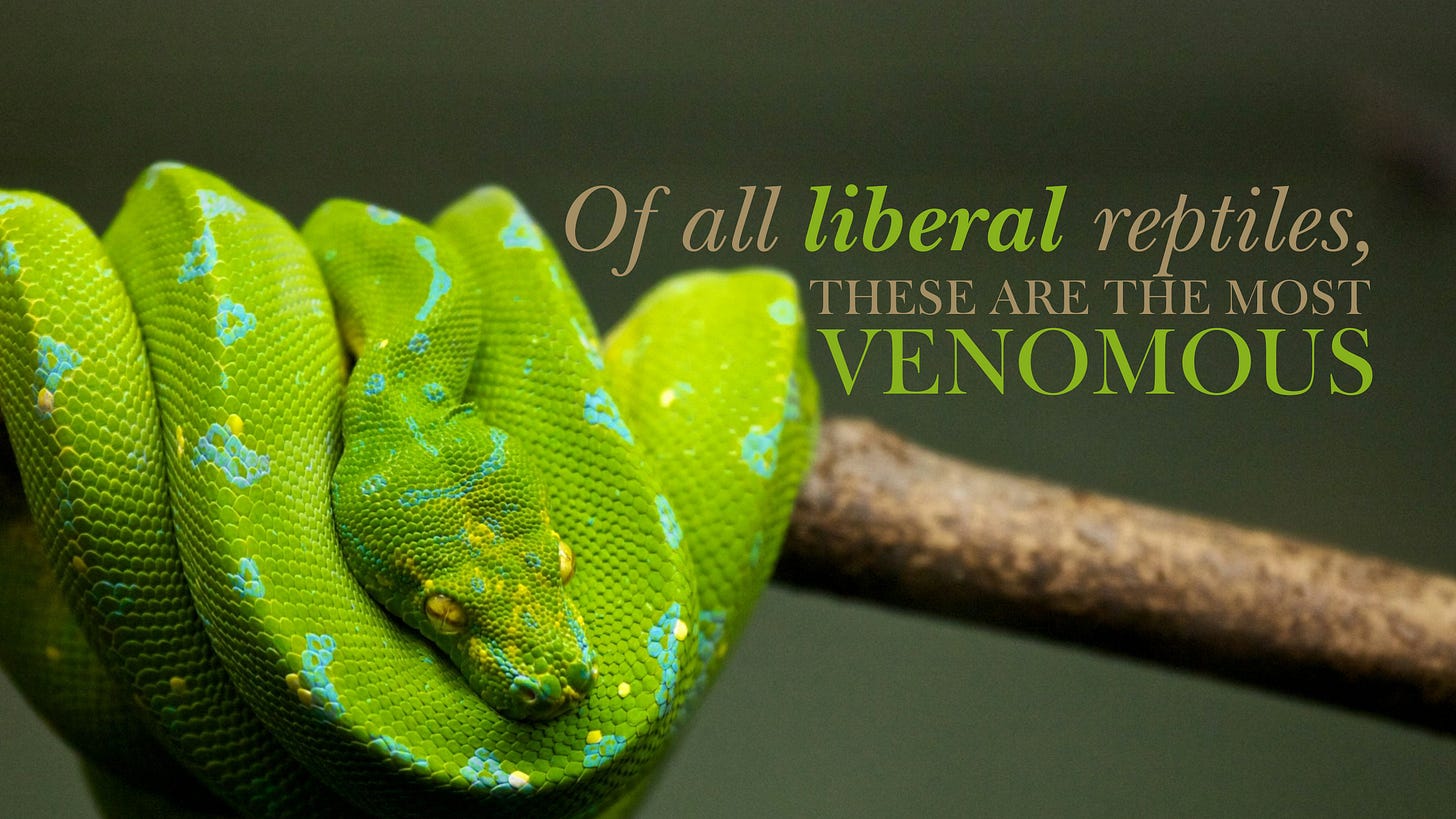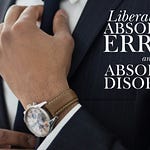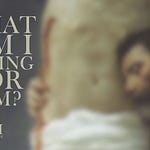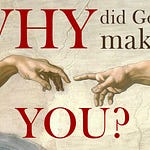
Returning to the classic work ‘Liberalism is a Sin,’ let’s see how and why Liberalism maintains its grip, even on Catholics – and how we can escape it. (Day 7 of Total Consecration)
Editor’s Notes
The first period of the preparation for St Louis de Montfort’s Total Consecration to the Blessed Virgin is focused on gaining a greater awareness of the spirit of the world, and emptying ourselves of it.
Today we return to Don Félix Sarda y Salvany’s classic work Liberalism is a Sin, to consider his analysis of how Liberalism – the spirit of the world par excellence – infiltrates the hearts of even the most stalwart Catholics. You can read a recent overview of the history of this work, and the controversy from which it arose, at
’s Substack here.We’re joined today by Theo Howard from The Two Cities Podcast, who has kindly agreed to read the section. You can find out about his work at his YouTube Channel – here’s a show in which The WM Review’s S.D. Wright appeared as a guest:
The audio attached to this piece is taken from a new translation of the original Spanish by
– albeit with a few tweakings. The text is a new translation made by The WM Review.As with the previous reading from Liberalism is a Sin, we recommend readers to return to the previous day’s meditation – that of “The Two Standards.”
The themes, as well as vocal prayers and readings associated with this ‘Week 0’, can be found here. You can find the book here.
Although this is part of the Total Consecration preparation, it also stands alone as a great text in its own right.
CONTENTS:
READING: The text consists of a few chapters from Don Sarda y Salvany’s Liberalism is a Sin. This text is intended to provide material for further consideration of the subject of this week.
MEDITATION: Repeat the meditation from yesterday, asking God to grant you a greater knowledge and detestation of the spirit of the world. A guide on how to use these points in meditation can be found here.
Reading: Catholics and Liberalism
Liberalism is a Sin
Don Sarda y Salvany
Base text translated with AI and every line compared for accuracy and readability.
VI. On so-called ‘Catholic Liberalism’ or ‘Liberal Catholicism’
Of all the inconsistencies and antinomies found in the intermediate gradations of Liberalism, the most repugnant and odious of all is that which claims to be nothing less than the union of Liberalism and Catholicism – to form what is known in the history of modern aberrations by the name of Catholic Liberalism or Liberal Catholicism. And yet illustrious intellects and most honorable hearts, whom we cannot believe to be anything but well-intentioned, have paid tribute to this absurdity. It had its epoch of fashion and prestige which, thank heaven, is passing or has already passed.
This fatal error was born of an exaggerated desire to establish conciliation and peace between doctrines that by their very essence are necessarily and irreconcilably hostile. Liberalism is the dogma of the absolute independence of individual and social reason; Catholicism is the dogma of the absolute subjection of individual and social reason to the law of God. How can one reconcile the yes and no of such opposed doctrines? To the founders of Catholic Liberalism it seemed an easy thing. They devised an individual reason bound to the law of the Gospel – but coexisting with it, a public or social reason free from all restraint in this particular. They said:
“The State as such State ought not to have a Religion, or ought to have one only to a certain point that does not disturb those who do not wish to have it. Thus, then, the private citizen must submit himself to the revelation of Jesus Christ; but the public man may conduct himself as such in the same manner as if said revelation did not exist for him.”
In this way they composed the celebrated formula: “A free Church in a free State,” a formula for whose propagation and defense several distinguished Catholics in France swore themselves, and among them an illustrious Prelate; a formula which should have been suspicious from the moment Cavour took it up to make it the banner of the Italian revolution against the temporal power of the Holy See; a formula of which, despite its evident failure, we have no knowledge that any of its authors has yet retracted.
These enlightened sophists did not notice that if individual reason was obliged to submit to the law of God, public or social reason could not be declared exempt from it without falling into an extravagant dualism that subjects man to the law of two opposing criteria and two opposing consciences. Thus the distinction between man as individual and as citizen – obliging him to be Christian in the first conception and permitting him to be atheist in the second – immediately fell to the ground under the crushing blow of integrally Catholic logic. The Syllabus, of which we shall speak later, finished burying it without remission.
There still remains from this brilliant but most disastrous school some belated disciple or other who no longer dares to sustain openly the Catholic-Liberal theory of which he was in other times a fervent panegyrist, but which he still obeys in practice; perhaps without giving account to himself that he proposes to fish with nets that, being old and well-known, the devil has already ordered put away.
VII. The essence or intrinsic reason of so-called ‘Liberal Catholicism’
If well considered, the intimate essence of that Liberalism which is called Catholic – by another name commonly called Liberal Catholicism – consists probably in nothing more than a false concept of the act of faith.
It appears, according to the account Catholic Liberals give of theirs, that they make the entire motive of their faith rest not on the authority of God, infinitely truthful and infallible, who has deigned to reveal to us the only path that must lead us to supernatural beatitude, but rather on the free appreciation of their individual judgment which dictates to man that this belief is better than any other. They do not wish to recognize the magisterium of the Church as the only authority authorized by God to propose revealed doctrine to the faithful and determine its genuine sense; instead, making themselves judges of the doctrine, they admit of it what seems good to them, reserving the right to believe the contrary whenever apparent reasons seem probable that what yesterday they believed as true is today false.
For the refutation of which it is sufficient to know the fundamental doctrine De Fide expounded on this matter by the holy Vatican Council.
For the rest they call themselves Catholics because they firmly believe that Catholicism is the only true revelation of the Son of God; but they call themselves Liberal Catholics or free Catholics because they judge that this belief of theirs ought not to be imposed on them or on anyone by any superior motive than that of their free appreciation. Without feeling it themselves, such people find that the devil has artfully substituted the naturalistic principle of free examination for the supernatural principle of faith. Wherewith, although they judge themselves to have faith in Christian truths, they have no such faith in them, but a simple human conviction, which is essentially distinct.
It follows from this that they judge their intellect free to believe or not to believe, and they likewise judge that of all others to be free. In unbelief, then, they see not a vice, or sickness, or voluntary blindness of the understanding, and even more so of the heart, but rather a licit act of each person’s internal jurisdiction, as much master in this matter of believing as in that of not admitting any belief whatsoever. For this reason, entirely consistent with this principle is their horror of any moral or physical pressure that comes from without to punish or prevent heresy, and hence their horror of frankly Catholic civil legislation. Hence the supreme respect with which they understand others’ convictions must always be treated, even those most opposed to revealed truth; for to them these are as sacred when erroneous as when true, since all are born of the same sacred principle of intellectual liberty. By this means, what is called “tolerance” is erected into a dogma, and a new code of laws is dictated for Catholic polemic against heretics, which the great polemicists of Catholicism never knew in antiquity.
The primary concept of faith being essentially naturalistic, it follows from this that all its development in the individual and in society must also be naturalistic. Hence the appreciation of the Church primarily (and sometimes almost exclusively) for the advantages of culture and civilization it provides to peoples; forgetting and almost never citing at all its primary supernatural end, which is the glorification of God and the salvation of souls. Several of the Catholic apologies written in the present age appear infected with this false concept. So much so that, for such persons, if Catholicism had unfortunately been the cause at some point of material backwardness for peoples, such a Religion would no longer be true or praiseworthy in good logic. And note that it could indeed still be so – just as undoubtedly for some individuals and families, being faithful to their Religion has been the occasion of true material ruin, without it thereby ceasing to be a most excellent and divine thing.
This criterion is what guides the pen of the majority of liberal newspapers, which if they lament the demolition of a temple, only know how to point out in this the profanation of art; if they advocate for religious orders, they do no more than extol the benefits they rendered to letters; if they praise the Sister of Charity, it is only in consideration of the humanitarian services with which she softens the horrors of war; if they admire worship, it is only in attention to its external brilliance and poetry; if in Catholic literature they respect the Sacred Scriptures, it is by fixing only on their majestic sublimity. From this manner of praising Catholic things solely for their greatness, beauty, utility or material excellence, it follows in strict logic that error deserves equal praise when it possesses such conditions, as doubtless some of the false cults apparently possess them on more than one occasion.
Even piety is reached by the malefic action of this naturalistic principle, which converts it into true pietism, that is, into a falsification of true piety. Thus we see it in so many persons who seek in devotional practices nothing more than emotion, which is pure sensuality of the soul and nothing more. Thus there appears today in many souls the Christian asceticism entirely vitiated, which is the purification of the heart by means of the confrontation of the appetites, and Christian mysticism misunderstood, which is not emotion, nor interior consolation, nor any other of those human delicacies, but rather union with God by means of submission to His most holy will and by means of supernatural love.
For this reason, much of the Catholicism practiced today among certain persons is liberal Catholicism, or better, false Catholicism. It is not Catholicism: it is mere Naturalism, it is pure Rationalism, it is Paganism with Catholic language and forms, if we may be permitted the expression.
VIII. Shadow and penumbra, or the extrinsic reason for this same catholic-liberal sect
Having seen in the previous chapter the intrinsic reason, or let us call it formal reason, of Catholic Liberalism, let us proceed in this present one to examine what we might call its extrinsic or historical reason – or material, if our readers prefer this latter scholastic qualification.
The heresies we study today, in the lengthy course of the centuries that lie between the coming of Jesus Christ and the times in which we live, present themselves to us at first sight as points clearly and definitively circumscribed in their respective historical period, it being possible apparently to indicate, as with a compass, where they begin and where they end, that is to say the geometric line that separates these black points from the rest of the illuminated field in which they extend.
But this appreciation, if one considers it well, is nothing more than an illusion of distance. A more careful study, which brings us closer with the telescope of good criticism to those epochs, and puts us in true intellectual contact with them, allows us to observe that never, in any of those historical periods, do the limits that separate error from truth appear so geometrically defined; not in the reality of it, which is very clearly formulated in the definition of the Church, but in its external apprehension and profession – that is to say, in the manner in which the respective generation has denied or professed it with more or less frankness. Error in society is like an ugly stain on a cloth of exquisite weave. One sees it clearly, but it is difficult to specify its limits; its frontiers are vague like the twilights that separate the dying day from the approaching night, and in turn the departing night from the dawning day. The error, which is black shadow, is preceded and followed and surrounded by what might be called vague penumbras, which can sometimes be taken for the shadow itself, still illuminated by some reflection or other of dying light, or as the light itself which is already tarnished and obscured by the first shadows.
Thus every error clearly formulated in Christian society had around it another kind of atmosphere of the same error, but less dense and more tenuous and mitigated. Arianism had its Semi-Arianism; Pelagianism its Semi-Pelagianism; ferocious Lutheranism its Jansenism, which was nothing more than a moderate Lutheranism. Thus, in the present age radical Liberalism has around it its corresponding Semi-liberalism, which is nothing other than the Liberal-Catholic sect we are examining here. It is what the Syllabus called a moderate rationalism; it is Liberalism without the frank crudeness of its principles laid bare, and without the horror of its ultimate consequences, Liberalism for the use of those who do not yet consent to cease appearing or believing themselves to be Catholics. It is Liberalism the twilight of truth that begins to be obscured in the understanding, or of heresy that has not yet come to take complete possession of it.
We observe, in fact, that liberal Catholics tend to be Catholics who are ceasing to be firm Catholics – or crude liberals who, partly disillusioned with their error, have not yet finished entering fully into the domains of integral truth. It is the subtle and most ingenious means that the devil always found to retain as his own many who otherwise would have truly abhorred his infernal machination, had they known it well. This satanic means is to permit such persons to still have one foot on the ground of truth, on condition that the other foot be already completely in the opposite field. Thus those not yet hardened in conscience avoid the salutary horror of remorse.
Thus, moreover, they free themselves from the commitments that every decisive revision always brings to timid and vacillating spirits, who are the majority; thus the opportunists manage to figure, as suits them, for a time in each field, trying to appear in both as friends and affiliates; thus, finally, man can offer as an official and recognized palliative for the greater part of his miseries, weaknesses and inconsistencies.
Perhaps the present question has not yet been duly studied from this angle in ancient and contemporary history; an angle which, being the least noble, is for that very reason the most practical, since unfortunately, in what is least noble and elevated one must commonly seek the secret spring of the greater part of human phenomena. It has seemed good to us to make this indication here, leaving to more expert and subtle intelligences the task of expanding and developing it completely.
IX. Another important distinction: practical Liberalism, and speculative or doctrinal Liberalism
It is taught in philosophy and in theology that there are two kinds of atheism: one doctrinal and speculative, the other practical. The first consists in denying openly and flatly the existence of God, attempting to nullify or ignore the irrefutable proofs on which it is founded. The second consists in living and acting without denying God’s existence, but as if God did not in fact exist. The former are called theoretical or doctrinal atheists; the latter, practical atheists – and they are the more numerous.
The same thing happens with Liberalism and with liberals: there are theoretical liberals and practical liberals. The former are the dogmatisers of the sect: philosophers, professors, deputies, or journalists who teach Liberalism in their books, speeches, or articles; who defend the doctrine of Liberalism with arguments and authorities and according to a rationalist criterion, in covert or open opposition to the criterion of the divine and supernatural revelation of Jesus Christ.
The practical liberals are the majority of the group – its sheep – who believe blindly what their masters tell them – or who, without believing it, follow docilely whoever leads them, always keeping step with him. They know nothing of principles or systems, and perhaps would detest them were they to see all their deformity; nevertheless, they are the hands that act, just as the theorists are the heads that direct. Without them Liberalism would never leave the precinct of the academies; they are the ones who give it outward life and movement. They pay for the liberal newspaper; they vote for the liberal candidate; they support liberal ministries; they cheer its leaders and celebrate its dates and anniversaries. They are the prime matter of Liberalism, ready to receive any form, and always ready to be used for any atrocity. Many of them once went to Mass and yet killed the friars; later they attended novenas, yet gave ecclesiastical careers to their sons, and bought properties from the confiscation; today they perhaps say the Rosary, and yet vote for the freedom-of-worship candidate. They have formed for themselves a sort of rule for living with the age, and they think (or wish to think) that this is going well for them. Does this excuse them from responsibility or guilt before God? Certainly not, as we shall see later.
Practical liberals are also those who, while avoiding any expounding of liberal theory – knowing that it is already discredited for certain minds – nevertheless try to uphold it in the practical procedure of everyday life: writing and holding forth in the liberal manner; proposing and choosing liberal candidates; praising and recommending their books and persons; judging events always by the liberal criterion; always showing stubborn hatred for anything that tends to discredit or belittle their beloved Liberalism. Such is the conduct of many “prudent” journalists, who are scarcely ever caught in the offence of formulating concrete liberal propositions – yet who nonetheless, in all they say and in all they leave unsaid, never cease from making the accursed sectarian propaganda. This is, of all the liberal reptiles, the most venomous.
Meditation for Day 7
(A repeat of Day 6)
It is in mental prayer that that much of the preparation will be achieved – and meditation is a means of entering mental prayer. See our guide to meditation for two ways to use the below texts.
The Two Standards: The one of Christ, our Commander-in-chief and Lord; the other of Lucifer, mortal enemy of our human nature.
It is in mental prayer that that much of the preparation will be achieved – and meditation is a means of entering mental prayer. See our guide to meditation for two ways to use the below texts.
In this preparation for the consecration of ourselves to the Blessed Virgin Mary, we should keep Our Lady in mind throughout our meditation. For example, Satan’s plans never succeeded with her, she defeats these plans, she is able to obtain for us a clear understanding of them, she is with Christ under his standard as the “Victorious Leader of Triumphant Hosts” (as the Byzantines call her), and so on.
The Preparation
Prayer. The usual Preparatory Prayer.
First Prelude. The First Prelude is the narrative. It will be here how Christ calls and wants all under His standard; and Lucifer, on the contrary, under his.
Second Prelude. The second, a composition, seeing the place. It will be here to see a great field of all that region of Jerusalem, where the supreme Commander-in-chief of the good is Christ our Lord; another field in the region of Babylon, where the chief of the enemy is Lucifer.
Third Prelude. The third, to ask for what I want: and it will be here to ask for knowledge of the deceits of the bad chief and help to guard myself against them, and for knowledge of the true life which the supreme and true Captain shows and grace to imitate Him.
The Points for Meditation
First Point. The first Point is to imagine as if the chief of all the enemy seated himself in that great field of Babylon, as in a great chair of fire and smoke, in shape horrible and terrifying.
Second Point. The second, to consider how he issues a summons to innumerable demons and how he scatters them, some to one city and others to another, and so through all the world, not omitting any provinces, places, states, nor any persons in particular.
Third Point. The third, to consider the discourse which he makes them, and how he tells them to cast out nets and chains; that they have first to tempt with a longing for riches—as he is accustomed to do in most cases—that men may more easily come to vain honour of the world, and then to vast pride. So that the first step shall be that of riches; the second, that of honour; the third, that of pride; and from these three steps he draws on to all the other vices.
One could consider these points in reference to oneself: How far have we been conscious of this in our daily lives so far, what practical conclusions should we draw from these truths, how far have we lived up to them so far, what must we do to live up to them in the future, etc.
One could consider the acts of virtue we can make in response to these truths – Acts of faith, humility, hope/confidence, thanksgiving, contrition and love – talking all the while to God, the Blessed Virgin, our Guardian Angels, etc.
So, on the contrary, one has to imagine as to the supreme and true Captain, Who is Christ our Lord.
First Point. The first Point is to consider how Christ our Lord puts Himself in a great field of that region of Jerusalem, in lowly place, beautiful and attractive.
Second Point. The second, to consider how the Lord of all the world chooses so many persons—Apostles, Disciples, etc.,—and sends them through all the world spreading His sacred doctrine through all states and conditions of persons.
Third Point. The third, to consider the discourse which Christ our Lord makes to all His servants and friends whom He sends on this expedition, recommending them to want to help all, by bringing them first to the highest spiritual poverty, and—if His Divine Majesty would be served and would want to choose them—no less to actual poverty; the second is to be of contumely and contempt; because from these two things humility follows. So that there are to be three steps; the first, poverty against riches; the second, contumely or contempt against worldly honor; the third, humility against pride. And from these three steps let them induce to all the other virtues.
The Colloquy
As mentioned above, it may be more fitting in this Week 0 (seeking a knowledge of the world) to apply the first triple colloquy here – and to repeat this meditation at a later point with the second triple colloquy below.
First Colloquy. One Colloquy to Our Lady, that she may get me grace from Her Son and Lord that I may be received under His standard; and first in the highest spiritual poverty, and—if His Divine Majesty would be served and would want to choose and receive me—not less in actual poverty; second, in suffering contumely and injuries, to imitate Him more in them, if only I can suffer them without the sin of any person, or displeasure of His Divine Majesty; and with that a Hail Mary.
Second Colloquy. I will ask the same of the Son, that He may get it for me of the Father; and with that say the Soul of Christ.
Third Colloquy. I will ask the same of the Father, that He may grant it to me; and say an Our Father.
Fr Ambruzzi offers some suggestions for colloquies (see the previous piece), but it is important to speak frankly to God in our own words, rather than simply reading somebody else’s.
If one feels moved to speak to God before meditating on all the points, one should certainly do so. The same applies if one feels moved to simply rest in God, rather than engaging in discursive meditation. These impulses should be followed over any particular method of meditation.
The End
End the meditation with a vocal prayer – such as the Our Father, the Anima Christi. Prayers from the Byzantine Paraclisis may be fitting for this 33-day preparation – for example:
Glory be to the Father and to the Son and to the Holy Ghost.
We who rejoice on account of thy gifts are aware that thou art the Mother of God: and so we sing to thee a hymn of gratitude, to thou who art perfectly pure!
Now and always and for ever and ever. Amen.
O thou who art worthy of all praise, whom we possess as our hope, our supporting strength, our indestructible wall of salvation, grant that we may be delivered from all afflictions!1
Reflect on how well we have prayed, and how well we have followed our chosen method.
Select a spiritual nosegay from your meditation to keep with you for the rest of the day.
See you tomorrow. Hit subscribe to make sure you don’t miss it or any of our other material:
For more on Liberalism:
For more on the St Louis de Montfort’s True Devotion and Total Consecration, for which we are preparing, see here:
The theological basis of ‘True Devotion’ and the Consecration to Mary (Garrigou-Lagrange)
The fruits of ‘True Devotion’ and Consecration to Mary (Garrigou-Lagrange)
For more on the importance of not getting bogged down with methods, and on allowing God to act, see here:
For more on Week 0, and the vocal prayers that are are suggested for each day, see here:
‘Week 0’ of St Louis de Montfort’s Total Consecration preparation (Prayers, practices and reading)
Get the book here:
True Devotion to the Blessed Virgin Mary (St Louis de Montfort)
HELP KEEP THE WM REVIEW ONLINE WITH WM+!
As we expand The WM Review we would like to keep providing free articles for everyone.
Our work takes a lot of time and effort to produce. If you have benefitted from it please do consider supporting us financially.
A subscription gets you access to our exclusive WM+ material, and helps ensure that we can keep writing and sharing free material for all.
You can see what readers are saying over at our Testimonials page.
(We make our WM+ material freely available to clergy, priests and seminarians upon request. Please subscribe and reply to the email if this applies to you.)
Subscribe to WM+ now to make sure you always receive our material. Thank you!
If you are enjoying this preparation for Total Consecration, why not get it in mug form?
Follow on Twitter, YouTube and Telegram:
Twitter (The WM Review)
These prayers are drawn from the ‘Office of Consolation’ or the Small Paraklesis (Παράκλησις, “supplication” or “comfort”), a service of intercession addressed to the Theotokos, and written by Theophanes/Theosterictus the Monk in the 9th century. The texts have been lightly adapted from the Melkite Byzantine Daily Worship.
The Paraklesis is chanted in times of distress and sorrow of soul, and daily during the first fourteen days of August in preparation for the feast of the Assumption. It is among the most beloved devotions of the Byzantine tradition.
We are offering a selection of these prayers to be used as readers see fit – at the start or end of meditation, for morning or evening prayer, or at any other time.









